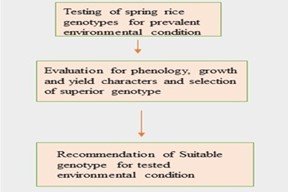Varietal evaluation of spring rice (Oryza sativa L.) genotypes in Kanchanpur, Nepal
Abstract
A field experiment was carried out on spring rice in the rabi season of 2022 from February 3 to July 4 with an aim to identify the most suitable spring rice cultivar in Kanchanpur, Nepal. The experiment was laid out in Randomized Complete Block Design (RCBD) with three replications and eight treatments. The treatments were eight spring rice genotypes: one released (Chaite-5), one local genotype (ChaineeAndi), and six pipeline varieties (IR17A2946, IR17A2796, IR17A2949, IR13F402, IR16A3838, and IR18A2066). A total of 24 experimental plots, each of 6m2 (3*2m), were set to the experimental design. The treatments were randomly assigned to the replications. Data were collected for various morphological characters such as plant height (cm), number of tillers (/plant), effective tillers (/m2), panicle length (cm), number of grains per panicle, sterility (%), thousand-grain weight (gm), grain yield (kg), straw yield (kg), biological yield (kg), and harvest index. Results revealed significance for all parameters except for the effective number of tillers per plant. ChaineeAndi took the least days to mature and had the highest effective tiller number per plant. Genotype IR17A2066 took the most days to flower and mature, and had greater plant height, thousand-grain weight, but low grain yield. Grains per panicle were higher in IR13F402 but lowest panicle length. Chaite-5 had the highest sterility percentage. Highest grain yield, straw yield, and harvest index was observed in genotypes IR16A3838, IR17A2946, Chaite-5, and IR17A2949. IR16A3838 performed superior than other genotypes in environmental conditions of Kanchanpur, Nepal.
Keywords:
Adoptability, Genotype, Performance, YieldDownloads
References
Ajay, J., Santosh, M., & Jha, R. K. (2020). Production economics and technology adoption of spring rice at Eastern Chitwan of Nepal. International Journal of Agronomy, 3(1), 13-18.
Choudhary, D., Banskota, K., Khanal, N. P., McDonald, A. J., Krupnik, T. J., &Erenstein, O. (2022). Rice subsector development and farmer efficiency in Nepal: implications for further transformation and food security. Frontiers in Sustainable Food Systems, 5, 740546.
Gyawali, P., Khanal S. (2021). Overview of agriculture in Nepal: Issues and future strategies. Fundamental and Applied Agriculture, 6(3), 323–335.
Krishi Dairy. (2022). Government of Nepal
Matias, J., Cruz, V., Garcia, A., & Gonzalez, D. (2019). Evaluation of rice straw yield, fibre composition and collection under Mediterranean condition. Acta Technological Agriculture, 43-47.
MOALD. (2021). Statistical information on Nepalese agriculture 2019/2020. Government of Nepal
MOALD. (2022). Statistical information on Nepalese agriculture 2019/2020. Government of Nepal
Papademetriou, M. K. (2000). Rice production in the Asia-Pacific region: issues and perspectives. Bridging the rice yield gap in the Asia-Pacific region, 220, 4-25.
Paudel, K. P., Tamang, S., & Shrestha, K. K. (2014). Transforming land and livelihood: Analysis of agricultural land abandonment in the Mid Hills of Nepal. Journal of forest and Livelihood, 12(1), 11-19.
Puri, P., Marahatta, S., Khanal, B., & Poudel, R. (2021). Assessment of growth and yield performance of different rice genotypes at Baniyani (Kechankawal-6) Jhapa, Nepal. Acta Scientific Agriculture, 70-79.
Salleh, S. B., Rafii, M. Y., Ismail, M. R., Ramli, A., Chukwu, S. C., Yusuff, O., & Hasan, N. A. (2022). Genotype-by-environment interaction effects on blast disease severity and genetic diversity of advanced blast-resistant rice lines based on quantitative traits. Frontiers in Agronomy, 4, 990397.
Saphi, D. K. (2016). Growth and yield of rice as influenced by seed rates and genotypes under aerobic condition. International Journal of Science and Research, 1219-1221.
Shah, P., & Akhtar, T. (2011). Varietal improvement of rice under rainfed condition of Parwanipur, Bara, Nepal. International Research Journal of Applied and Basic Science , 423-425.
Shrestha, S., Shrestha, J., Kc, M., Paudel, K., Dahal, B., Mahat, J., & Ghimire, P. (2022). Performance of spring rice cultivars against planting methods in western terai, Nepal. Tropical Agroecosystems (TAEC), 3(1), 23-26.
Subedi, S., Sharma, S., Poudel, A., & Adhikari, S. (2018). Varietal evaluation and preference analysis of promising spring rice genotypes in Dhamilikuwa, Lamjung, Nepal. Open Journal of Plant Science, 3(1), 015-017.
Subedi, S., Sharma, S., Poudel, A., Adhikari, S., & KC, B. (2018). Varietal evaluation and preference analysis of promising spring rice genotypes in Dhamilikuwa, Lamjung, Nepal. Acta Scientific Agriculture, 2(7).
Timsina, K. P., Gauchan, D., Gairhe, S., Subedi, S. R., Pokhrel, B. B., Upadhyay, S., & Shrestha, J. (2023). Rice demand and production projections for 2050: Opportunities for achieving self-sufficiency in Nepal. Nepal Agriculture Research Journal, 15(1), 163-180.
Tripathi, B. P., Bhandari, H. N., &Ladha, J. K. (2019). Rice strategy for Nepal. ACTA scientific Agriculture, 3(2), 171-180.
USDA. (2022). Rice Outlook: August 2022 Nathan W. Childs, coordinator Bonnie LeBeau, contributor. United States department of Agriculture.
Won, P. L., Liu, H., Banayo, N. P., Nie, L., Peng, S., Islam, M. R., & Kato, Y. (2020). Identification and characterization of high-yielding, short-duration rice genotypes for tropical Asia. Crop Science, 60(5), 2241-2250.

Published
How to Cite
Issue
Section
Copyright (c) 2023 Agriculture and Environmental Science Academy

This work is licensed under a Creative Commons Attribution-NonCommercial 4.0 International License.

